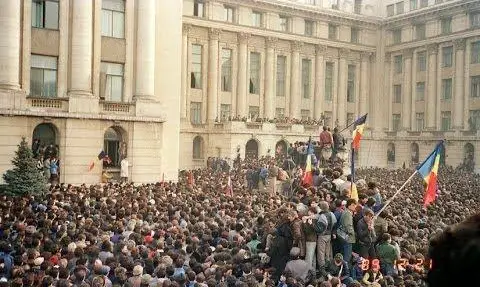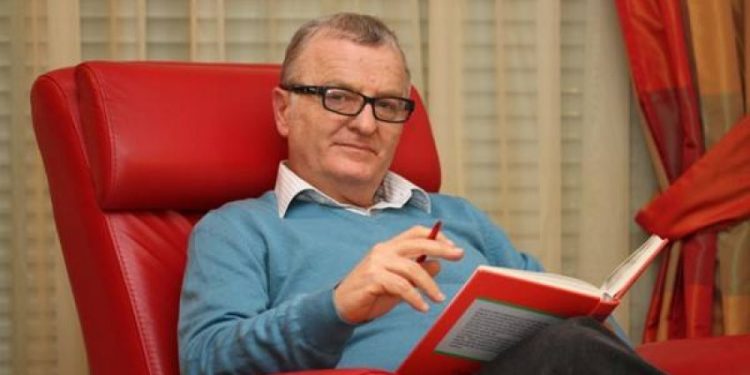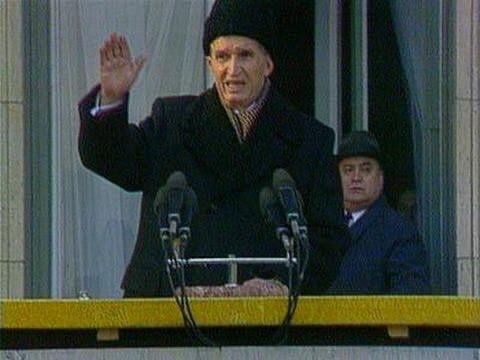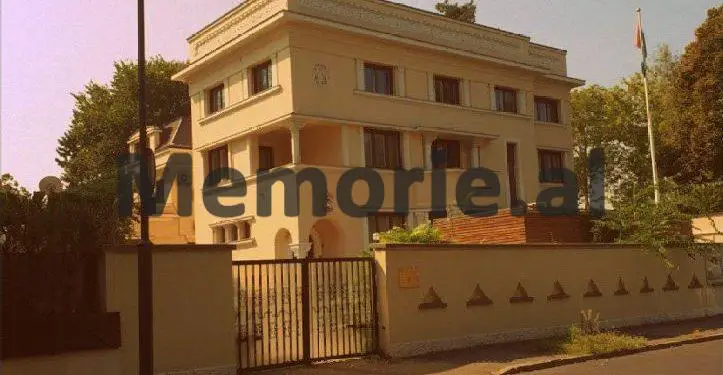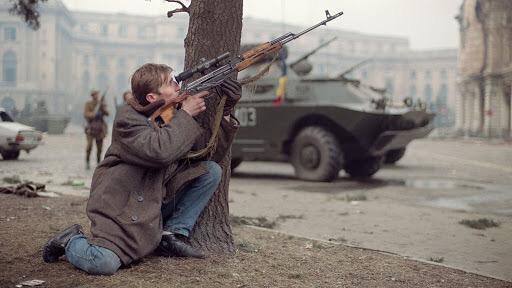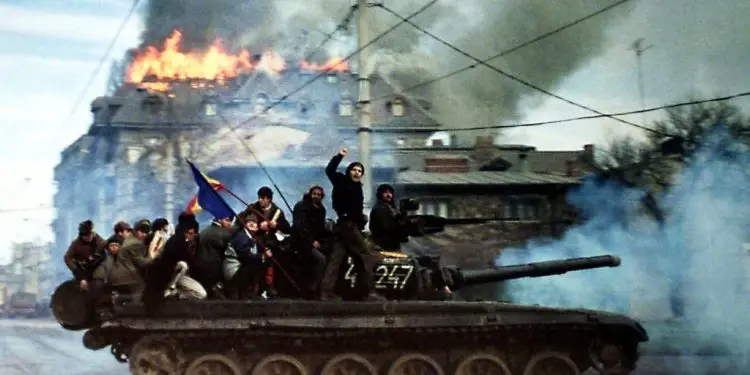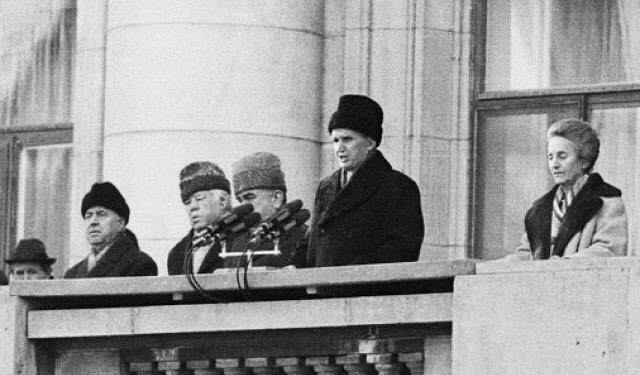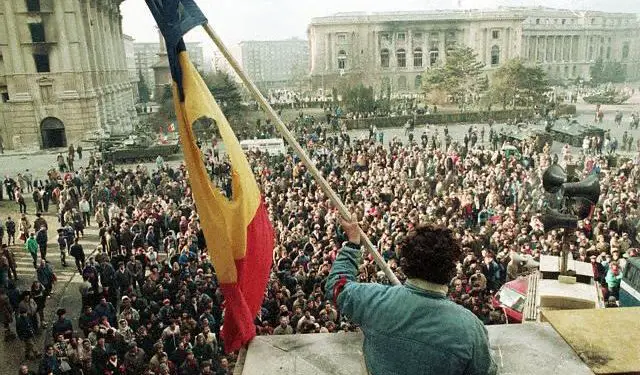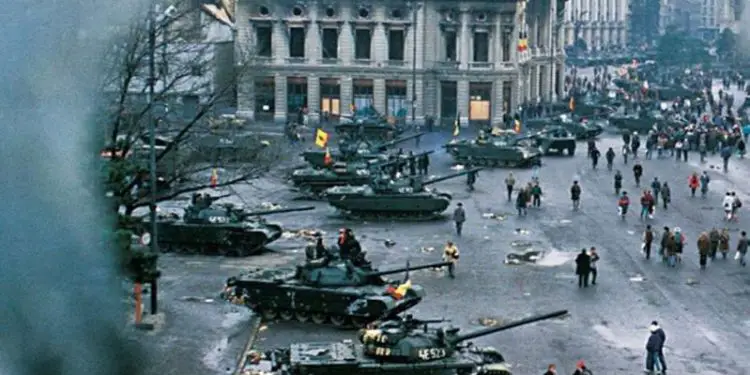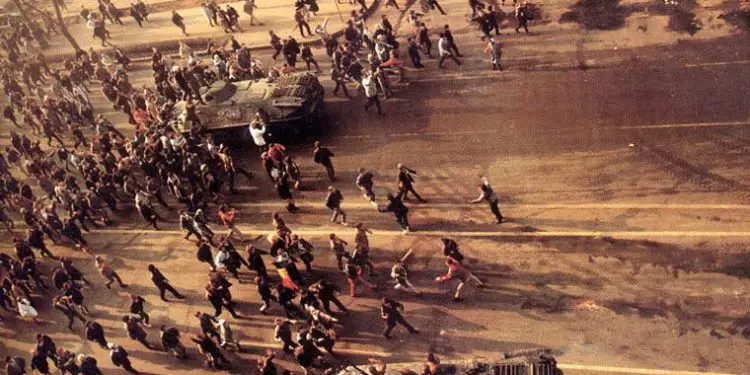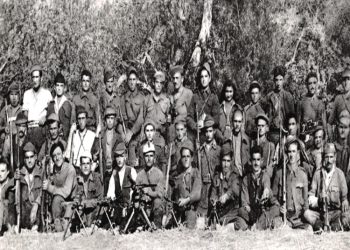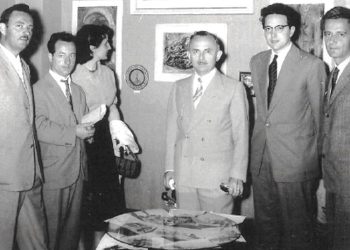Dashnor Kaloçi
The fourth part
Memorie.al publishes the unknown story of the mass protests of the Romanian people at the end of December 1989, which led to the overthrow of the communist leader, Nicolae Ceausescu, who had ruled the country since 1965, after the death of George Dezhi. Rare testimonies of the well-known journalist and moderator, Rezar Xhaxhiu, who from 1987 to March 1991, served as Press and Culture Attaché at that embassy, which exclusively tells Memorie.al, making public for the first time, how the staff of that embassy, led by Ambassador Pirro Vito, experienced the sensational events of the mass protests of the Romanian people, where for several days in a row, the staff of that diplomatic headquarters was forced to take up arms and take up positions in different parts of that building? What messages did they receive from official Tirana through the Ministry of Foreign Affairs and how did they get through the most difficult moment, when the Albanian embassy was surrounded by Army tanks commanded by General Vasile Milea who had joined the protesters, after the news broke that the dictator Romanian, Ceausescu, with his wife, Helena, were sheltered in the basements and tunnels of that embassy?!
“I remember that all the family members of the staff of our embassy, had gathered together and stood in the basements of that building, under a real uncertainty and panic, of what could happen in the following hours! Meanwhile, that part of our families who were sheltered, outside the embassy building, experienced twice and more with fear, the battle of several days on the streets of Bucharest. I remember my friend, whom I found every time I came back from the embassy, terrified and stiffened by panic, fear, and insecurity. At the time, we had a 6-month-old daughter, and I often found them both under the window sill, to escape the bullets coming from everywhere. It was fired from all sides, and those who were most treacherous were the Securitates’ USLA (Special Anti-Terror Unit) cyberattacks, which were placed on the terraces of palaces, and official buildings. But in many cases, it was not known who was shooting?! It was Christmas Eve, December 25, 1989, when we learned of Ceausescu’s arrest. He and his wife, Elena, were stopped by an army checkpoint near Targovishte. “During this moment, the presidential couple Ceausescu, was heading to an airport, trying to escape from Romania, and seek political asylum in a country friendly with Romania.”
This is how the well-known journalist and moderator Rezar Xhaxhiu remembers, among other things, the sensational events that took place three decades ago in Romania, where at the end of December 1989, due to the mass protests of the Romanian people in the capital of the country. , Bucharest, communist leader Nicolae Ceausescu and his wife, Helena, were detained at a checkpoint on the outskirts of a small town on the border with Hungary in an attempt to flee the country. executed after a ‘flash’ trial!
Located in the ranks of the diplomatic service (as Attaché of the Press and Culture), near the Albanian Embassy in Bucharest since the beginning of 1987, as an eyewitness, Xhaxhiu, had the opportunity to follow closely the protests of the Romanian people, which led to the overthrow of dictator Nicolae Ceausescu, who had ruled that great Balkan country since 1965, after the death of George Dej.
How was Rezar Xhahiu selected to serve in the ranks of Albanian diplomacy, who were the other colleagues he worked with from 1987 until March ’91 when he returned to his homeland, how did the work at that diplomatic headquarters work? and how the staff of that embassy, led by Ambassador Pirro Vito, experienced the sensational events of the mass protests of the Romanian people in late December 1989, where for several days, the staff of that diplomatic headquarters was forced to arm themselves and took positions in different parts of that building?
What messages did they receive from official Tirana through the Ministry of Foreign Affairs and how did they get through the most difficult moment when the Albanian embassy was surrounded by Army tanks commanded by General Vasile Milea, after the news broke that Romanian dictator Ceausescu and his wife his, Helena, were sheltered in the basements and tunnels of that embassy?!
Regarding these and other unknown events that took place in the Albanian embassy accredited in Bucharest in the period, 1987-1991, Rezar Xhaxhiu tells us for the first time, in this exclusive interview for Memorie.al, which will continue in some consecutive numbers.
Continues from the last number
Mr. Xhaxhiu, at the time you served as a diplomat, did you have the opportunity to meet the famous Romanian communist leader, Nicolae Ceausescu?
I met Nicolae Ceausescu only once during the official ceremony of handing over the credentials by Ambassador Pirro Vito. We talked to him, as part of the staff of the Albanian embassy, for about an hour.
Can you describe the episode of this meeting, and what was discussed in it?
As far as I can remember, he was short, pale, petite, and extremely careful in formal conversation. Conversation which, was more than general, as are the conversations in these kinds of ceremonies. It discussed the relations between the two peoples, the role of the Albanian community in Romania, the economic relations between Tirana and Bucharest, and such general things.
Apart from this case, did you have any other meeting moment with Ceausescu?
Apart from this occasion of presenting the credentials of the newly arrived ambassador Pirro Vito, I no longer had the opportunity to meet with the communist dictator of Romania.
We are in 1989, the decisive year for the overthrow of the communist regime in Romania. How do you remember the development of the first protests and protests in this country?
1989 for the Romanians was the year that would bring great change for them and for Romania. This is due to the fact that at the beginning of that year, Ceausescu stated that he had zeroed in on the billion dollars he had borrowed from the West in the early 1970s. This debt was repaid, and at a Party Congress, Ceausescu declared with rage, that: ‘now for the Romanians, the great turn would begin’, which was conceived differently in the people, even as the great abundance!
Were there any economic and social changes in Romania after Ceausescu’s debt repayment?
Over the months, the economic and social situation not only did not improve, but continued to deteriorate more and more. By the end of 1989, there were only canned pickles and marmalades in Bucharest shops, and in all shops in Romania. There were only small basic things to keep the soul alive. Everything, it was rationed and there was no abundant food at all, as it was propagated!
Seen through the eyes of a diplomat, did you foresee that these silent protests would escalate into violent demonstrations?
Certainly, this grave condition caused a silent discontent to grow and accumulate, which would spread in a circle from the center, towards the outskirts of Romania. Everywhere was felt a charged situation, an internal tension, and a state which, could explode from moment to moment. Meanwhile, Romanian state television, which at the time broadcast only four hours of programming (of which only the presidential couple Ceausescu spent three hours), continued to broadcast endless documentaries on the achievements of Romanian industry!
As the chronology of these events proves, the starting point of the riots in communist Romania would be the clashes that would take place in the so-called “Timisoara Massacre”. How do you remember that tragic event?
Then we come to the famous “Timisoara Massacre”, which took place after the arrest of a reformist pastor of Hungarian origin, named Laszlo Tokesh, I remember, which was December 15th. That, was a day with a scary snow. People gathered in the center of the city of Timisoara, in the form of a protest. It was the first time this had happened in Romania, since World War II. Protesters erupted in calls and slogans against the regime. That was enough to get everything out of control, and then move on to a massacre of protesters.
After the 1990s, many Romanian and foreign analysts pointed out that the massacre was instigated by the Securitates’ USLA (special forces), who, disguised as civilians, fired sniper shots at the terraces of buildings. From the information you have does this stand and what is your opinion about this event?
In fact, even in that period, this news circulated a lot, not only in the Romanian public opinion, but also in that of other liberal segments of the Romanian Politburo. It should be noted that during the period of demonstrations and bloody fighting in Romania, the Armed Forces of the Ministry of Defense joined the people, while the Armed Forces of the Ministry of Internal Affairs, ie Securitate, remained loyal to them. almost to the end, the Ceausescu regime.
But after this massacre, how was the situation there in Bucharest, but also in all of Romania?
After that, I remember that Ceausescu, at this time, returns urgently from a visit he was making to Iran and on December 20, he gave a speech in which he described the citizens of Timisoara as “Enemies of the Socialist Order”! While he did not forget to mention the achievements of the socialist system of Romania. But what would ignite the hatred and revolt of the people even more, was an idiocy of his wife, Elena, who said on state TV that: ‘The bodies of the protesters killed in Timisoara should be nailed to the fence posts,’ to make everyone remember ‘!
How did you find out about these events, and where did you follow them?
For example, the events in Timisoara, we at the embassy followed through foreign radios, such as ‘VOA’ or ‘Radio BBC’ and the French ones, but also through numerous reports, which came to us from the Ministry of Foreign Affairs, in Tirana.
Did Ambassador Pirro Vito communicate any official directives regarding these events, and if so, what did he tell you?
At this time, in fact, we received instructions from the center (Ministry of Foreign Affairs in Tirana), but also from Ambassador Pirro Vito himself, who told us that: ‘we must be vigilant in our movements’. This vigilance had to be extended in relation to the Romanians, as nothing was known about what might precipitate in the days and weeks to come!
Did you attend the big rally held in the center of Bucharest by Ceausescu, and if so, how do you remember it?
Now, let’s get to the famous December 20th rally. I remember like today, that giant manifestation, as I was somewhere at the end of the crowd. It was a beautiful day, with plenty of sunshine, though very cold. A characteristic cold of Bucharest. A large crowd had filled the square in front of the building of the Central Committee of the Communist Party of Romania, until the moment when Nicolae Ceausescu himself appeared on the balcony of this building. He began to deliver one of his stale and colorless speeches, calling as “enemies of socialism and Romania” all those who took part in the Timisoara revolt. And that ‘Romania, after this revolt, will be better, that it will move to an increase in salaries and pensions’, etc., etc. But, suddenly at this moment, from the end of the crowd is heard a: ‘alo’, ‘alo’, and then an explosion, which was never understood what it was! At that moment, thousands of people raised red flags and banners in protest, along with pictures of Ceausescu, and shouted, “Timisoara,” “Timisoara.”
Did Ceausescu react after that?
Seeing what was happening, Ceausescu froze for a moment, as he could not believe his ears and eyes, for what was happening in his eyes!
What happened to Ceausescu after this anti-rally that had just started?
He then went on to call, trying to calm the crowd, saying these words, “Comrades…, calm down, do not disperse, stay in your places, comrades.”. But from below, he got an answer, which only he did not expect. The angry crowd shouted, “Jos Ceausescu” (below Ceausescu), “Ceausescu, cine esti, criminal din Scornicesti” (Who is Ceausescu, a criminal from Scornicesti), “Nu vai frie frica, Ceausescu pica” (Do not be afraid), that Ceausescu, ra) etc., etc., sayings like these. Then, his bodyguard intervened, pulling him violently from the balcony, to insert him inside, and then, to evacuate him by helicopter, in an unknown direction. This was the beginning and the beginning of everything, that would follow in the days to come in communist Romania.
As an eyewitness to the armed revolts that erupted there in Bucharest, what can you tell us about them, how do you remember them?
In the hours and days that followed, all of Bucharest plunged into unprecedented chaos and tension. Thousands stormed the building of the Casa Poporului (or “People’s Palace”), then the residence of Nicolae Ceausescu, and began raiding and burning down his works., which flew torn and burned, from the large balcony.
It is said that it strikes giant and at the same time luxurious, had destroyed the budget of the Romanian state?
Yes, it is true, that luxury building cost the budget of the communist state of the time very expensive, which would significantly impoverish even the pockets of ordinary Romanians. It was like a “Versailles of the Balkans”, as this building is the largest in Europe, and the second in the world, after the US Pentagon. There were fights everywhere in the boulevards and blocks of buildings, in important institutions, such as post offices, hospitals, administrative offices, police stations, etc. The Securitate headquarters building was almost burnt down by armed clashes between demonstrators and guards.
What happened to the fierce fighting in the following hours?
On the evening of that date, the repression led by the Minister of Defense, General Vasile Milea, began. Everything lasted two to three days. The Army, tanks, Police, Guard, Border Forces, Securitate, with its units, such as the Special Unit for the Fight against Terrorism, called USLA, etc., were mobilized, state segments. But the greatest disgrace, happened to the officers of the Securitate and the USLA, who, dressed as civilians, and fired weapons against the people, from any possible direction. General Milea, in the following days, after a heated debate with Ceausescu and other high-ranking communist hierarchs of the regime, refused to line up the army in their ranks, and committed suicide. This would further strain the situation, both among the people and the government.
How would the armed clashes continue in the following days, and what was the culminating moment of those events?
On the morning of December 22, thousands of workers from the Bucharest suburbs marched to the center, in the University Square, where a large part of the Army was also on the tanks, but then, a brotherhood occurred between them, with flowers and hugs! But everything then succumbed to chaos, destruction, barricades, tanks, assassinations, and a tension that was present, mostly in Bucharest and much less in other cities of the country. Both sides were involved in fierce fighting and killings in all possible ways. Demonstrating revolutionaries, after discovering the agents of Securitates, and other departments of the Romanian Ministry of Internal Affairs, publicly lynched them, and in many cases executed them. So, did members of the State Security (Securitates) who, after arresting or, in many cases, abducting civilians or demonstrators, torturing them in police station cells, and then killing them.
How much information could you have had at that time; how many were killed on both sides?
As a result of these clashes, it was said that nearly 2000 people were killed and over 5000 others were injured. But the exact figures were never made public.
What was the attitude of the Albanian embassy during the development of these events?
We, as the embassy, followed carefully, step by step, all the events that were aggravating with great speed from moment to moment. According to the information we received in different ways, we definitely maintained our attitudes as well. We first had to clarify, what was this new team that was replacing the Ceausescu regime, and led by a former friend of his, Ion Iliescu, what role the Securitate and the Army were really playing, and what attitude we had to take, in relation to all the rapid developments that were taking place.
Did you communicate with official Tirana about these events, and what were the directives they gave you?
Communications were frequent and Tirana was following them with great care and concern, everything was happening in those days in Bucharest. This was also noticed in the frequent telegrams that arrived from the Ministry of Foreign Affairs, regarding our attitudes, be they diplomatic, but also personal. Here I mean, the advice that came to us ‘to be careful, prudent but above all, safe for us and our families’.
You as a diplomatic corps, have you had any particular episodes related to these bloody fights?
I remember one day, it was morning and in one of my driving movements through the boulevards of Bucharest, together with the driver, we were stopped in the middle of the road by a group of teenagers somewhere between 15-16 years old armed, and who had built a checkpoint with different items. They signaled us to stop and asked us to get out of the car./Memorie.al
Continues tomorrow




